Photo

Joan Ponç (1927-1984) — Insects Suite (mixed media on paper, 1967)
175 notes
·
View notes
Text

Robert Ryman, Untitled, 1965
Enamel on bristol board, 8 x 8 in.
Collection: MoMA
29 notes
·
View notes
Text

Robert Ryman, Series #11 (White), 2003
Obituary by Adrian Searle for The Guardian, Feb 2019
"Ryman began painting in his apartment in the mid-1950s, often beginning with a colour that was then overpainted in a rime of biscuity, trowelled white marks. Some paintings were unstretched, on uneven scraps of linen. Some were explosive, or almost like coughs, or discarded paint rags or scraps that had been used to test a colour of a particular consistency of paint. Flecks of colour and the odd worm of paint, straight from the tube, curled from the mass of mostly white pigment. It was as if Ryman was trying to understand how layering and mixing, texture and touch could come together on a surface as an accumulation of actions and traces. They were very nearly not paintings at all, but a sort of residue, or an unfinished chain of thoughts that had just petered out, dwindled to a gasp or a sigh. Each painting was like an excerpt or an interruption, a barely begun jazz solo that had faltered to a stop. They are delectable things, all the better for being so truncated. Ryman, from the start, had a great touch. He also knew when to stop."
Aaron Betsky on the architectural quality of Ryman's paintings for Dezeen, Feb 2019
"Ryman's white was different. It had body and materiality. It was a thing, floating on, grabbing onto, or permeating another thing, canvas. It changed colour depending on how you stood or what the light was like. It was, in other word, real and even spatial. [...] If making the most perfect white and abstract structure was one of the holy grails of modernist architecture, then Robert Ryman came closer than anyone I know to fulfilling a version of that quest."
9 notes
·
View notes
Text
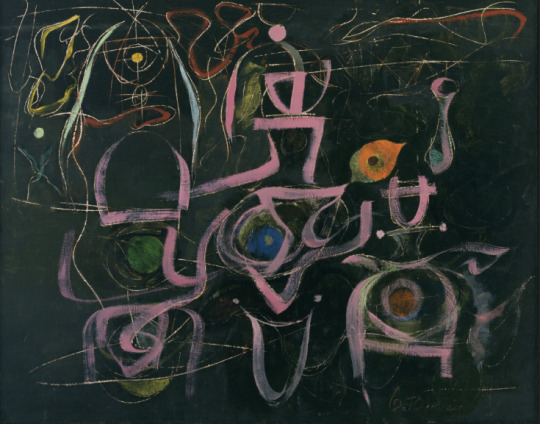
Bradley Walker Tomlin, Number 3, 1948
Oil on canvas, 40 x 50 in.
Collection: MoMA
78 notes
·
View notes
Text

Bradley Walker Tomlin, Tension by Moonlight, 1948
Oil on canvas, 32 x 44 in.
Collection: Everson Museum of Art, Syracuse, NY
"During most of his career, Tomlin painted lyrical Cubist still lifes while teaching at Sarah Lawrence and assorted boys’ schools. In the mid-1940s, he was influenced by the Abstract Expressionist painter Adolph Gottlieb. Experimenting with the semiautomatic methods used by Gottlieb and many Abstract Expressionists, he created graceful works, such as Tension by Moonlight (1948), that reflect his interest in Japanese calligraphy. He soon regarded such aesthetic freedom with suspicion, however, and began to paint more premeditated pieces, such as Number 9: In Praise of Gertrude Stein (1950), in which calligraphic and typographic shapes form a floating, but controlled, network over the entire surface of the canvas. During the remaining years of his life, he produced many paintings in subtle variations of this style, imbuing all his works with a distinctive melancholy." (via)
10 notes
·
View notes
Text
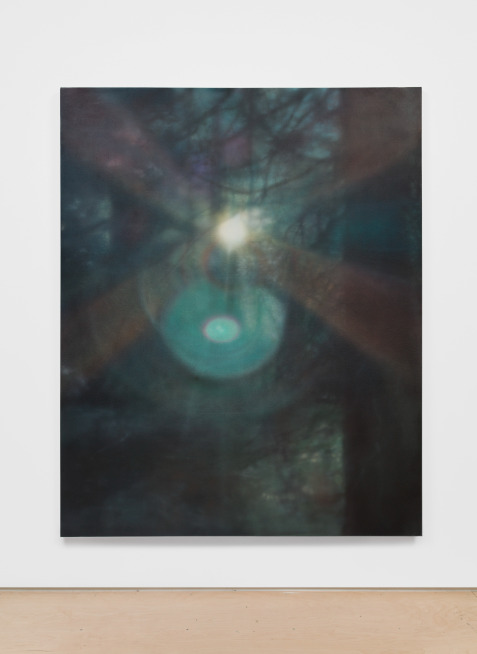

Leon Xu at Helena Anrather, New York
From the exhibition text, written by Hua Hsu:
My obsession with Leon’s work grows out of how it makes me feel, and I can only describe that in terms of what those feelings remind me of: a friend’s story where you can visualize almost everything but definitely not everything. A beautiful song dopplering out of a passing car; it’s gone just as you recognize it. A mental screenshot from a movie you haven’t seen since you were a teenager. A face across a smoke-filled room; you can’t make out whether they’re in agony or ecstasy. Something remarkable that you try and take a picture of, only it looks wack on your phone. You keep the picture anyway, as a reminder of what you once saw.
There are no lines or borders in Leon’s paintings, just these wondrous, meticulous blurs that come into focus from a distance, and the effect is realizing that you’re not looking at a painting about reality, but about memory. These were paintings of meadows and fields, various angles of a car, a cool sign, a bouquet; these were paintings of memories, and of that moment when you recognize you are seeing something special.
And then you realize that Leon’s paintings are invitations, not to ride along through his past, but to recognize the splendor of your present. He’s trying to pass on that chill you feel when you witness something unexpectedly sublime, whether it’s the sun hitting just right off the dashboard, or a neon sign slicing through late-night mist. Most of us never notice.
3 notes
·
View notes
Text

Mark Rothko, Orange, Red, Yellow, 1961
Acrylic on canvas, 93 x 81 in.
Collection: Private
Sold at Christie's art auction in 2012 for $86,882,500
Acquired from Marlborough Fine Art in London in 1967 by David Pincus, one of the leading American collectors in the second half of the century, the picture, consigned from the connoisseur’s estate, had never appeared in the market during the intervening 45 years
The price for Rothko's painting was expected to top out near $45 million based on presale estimates. When the record-setting 2012 auction price reached $70 million, three bidders remained competitive. The bidding extended for over six and a half minutes, "...one of the longest bidding matches yet witnessed in a contemporary art sale."
Kelly Crow of The Wall Street Journal ... noted that "auction specialists say collectors historically pay more for works that are red and gold, as opposed to gray." (Link)
6 notes
·
View notes
Text
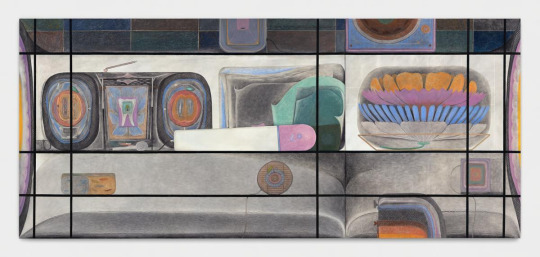
Krzysztof Grzybacz, Set, 2023
Oil on canvas (across 2 canvases), 79 x 181 in.
On view at Harkawik, NY, Feb 25 to Apr 2, 2023
From the exhibition text, written by staff of the gallery:
Grzybacz invites us to experience a world both familiar and alien, in which the body itself is as much a networked device, a sensate orchestra, and a bustling manufactory, as the technologies that have come to alter our understanding of it.
Grzybacz culls imagery from a heap of drawings, performing each work in a feverish 24 to 72 hour stretch, during which the canvas is covered with paint and then “mopped up” with sponges and brushes. This leaves areas of density and opacity, and the paintings that result loom over the viewer with the finitude of granite and the freedom and joy of a succinctly executed watercolor.
In Grzybacz’s world, pathways of communication, causal relation, and private ideation are all made external, visible. He composes by packing an array of incompatible perspectives into the same picture, layering and iterating them until the painting offers an impossibly comprehensive and diagrammatic look at an encounter or activity.
In the Coke-bottle-green Talk, the object and organs of pleasure and speech are concretized in a yammering geyser of spawning sex.
[In Set, 2023,] he employs what Jean-François Lyotard called “the libidinal band,” or a corporeal moebius strip that registers the primary processes of desire and libidinal intensity along its surface. The objects that occupy these quadrants—vibrator or microphone, tooth or flower, turntable or atomic bomb—function like dispositifs, channeling energy into stable systems of knowledge and reproduction.
In our current moment, when factory floor, chemical photograph, contraption, appliance and augmented body have given way to rubberbanded scrolling, to pinching and swiping and new economies of attention and reputation, Grzybacz illuminates our uncomfortable and unresolved sense of our own corporeal form, told to us countless times a day by the devices that fill our world.
3 notes
·
View notes
Text

Lucien Freud, Hotel Bedroom, 1954
Oil on canvas, 40 x 30 in.
Collection: Beaverbrook Art Gallery, Fredericton, NB
18 notes
·
View notes
Text

Alfatih, Day in the Life, 2023
Moving image, two-channel sound, 59:18:40
On view at Swiss Institute, NY, Jan 25 to Apr 23, 2023
"In the film, scripted by AI with prompts from the artist and scored by musician and theorist Tapiwa Svosve, over the course of a narrated, abridged 24 hours, we watch the baby move through its daily routine and rituals including sleeping, drinking coffee, working on a laptop, reading, and playing the piano. Observing the baby as it passes the time with different actions and choices, we may feel a sense of satisfaction, our own urge to be productive satiated as it swiftly grows and learns. Time stamps demarcate each recurring action of the mundane day, revealing the quiet melancholy of this solitary life." (Text via the Swiss Institute.)
1 note
·
View note
Text

Paolo Uccello, The Hunt, c. 1470
Oil on canvas, 26 x 65 in.
Collection: Ashmolean Museum, Oxford
1 note
·
View note
Text

Piero della Francesca, Flagellation of Christ, c. 1470
Oil and tempera on panel, 23 x 32 in.
Collection: Galleria Nazionale delle Marche, Urbino (x)
3 notes
·
View notes
Text
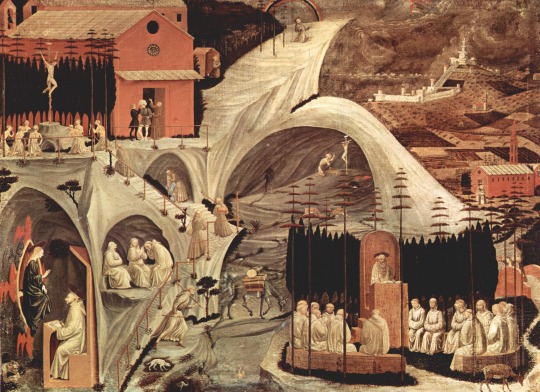
Paolo Uccello, The Thebaid, c. 1460
Tempera on canvas, 32 x 43 in.
Collection: Galleria dell’Accademia, Florence (x)
3 notes
·
View notes
Text

Piero della Francesca, The Baptism of Christ, 1437 (after)
Egg on poplar, 66 x 46 in.
Collection: The National Gallery, London
“As well as rooting the scene in the local area, Piero also uses mathematics to make it look convincingly three-dimensional. Piero – whose father had hoped he would become a merchant, like him – was thoroughly trained in mathematics. He was the first artist to write a treaty on perspective, De prospectiva pingendi, using mathematics to explain how to paint objects in proportion so that they appear in the painting as they are seen in real life. Here he used a grid structure as a guide for the placement and scale of objects. The layering of the elements of this picture – the angels occupy a space between two trees, and the man removing his gown is set between the distant figures in their elaborate headdresses and John the Baptist – echoes this invisible grid. The figures, carefully placed behind one another and gradually getting smaller, lead us into the painting, as does the river that winds away from us. In this way, Piero emphasised the depth of the landscape and the harmony of the figures and natural features within it.” (x)
4 notes
·
View notes
Text
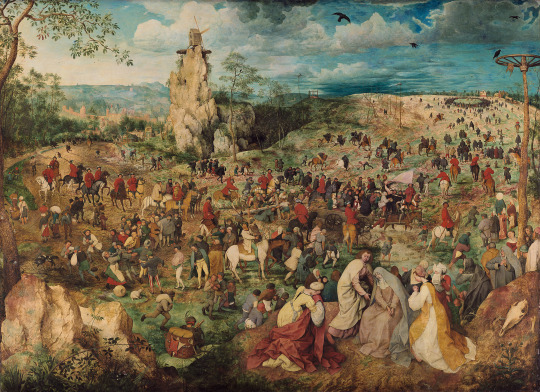
Pieter Bruegel the Elder, The Procession to Calvary, 1564
Oil on panel, 49 × 67 in.
Collection: Kunsthistorisches Museum, Vienna (x)
4 notes
·
View notes
Text

Antonio Ciseri, Ecce Homo, 1891
Oil on canvas, 115 x 150 in.
Collection: Galleria dell'Arte Moderna, Palazzo Pitti, Florence
"The phrase "Ecce Homo", literally "Behold the Man", refers to the Gospel's episode narrated by John in which Jesus Christ was presented to the Jewish people. Antonio Ciseri addressed that sacred subject in the same way as a historical event.
This is a painting of considerable size, made in almost 20 years, from 1871 to 1891, and currently preserved in the Gallery of Modern Art of Pitti Palace. A real "mise-en-scène" with references to the great Italian drama of that time, solutions borrowed from photographic technique and allusions to Ernest Renan's literary work, The Life of Jesus. Pontius Pilate presents Jesus from behind with a magniloquent gesture. Nobody shows their face, except for the wife of the Roman governor, caught in a moment of intimacy together with her servant. She almost seems to whisper her conviction that Christ is innocent." (x)
0 notes
Text


Roni Horn, Untitled (“Y is for the ambush of youth and escaping it year by year.”), 2013–2017
Solid cast glass with as-cast surfaces with oculus, 15 ¼ x 42 in.
‘In the glass pieces, what fascinates me has a lot to do with the essence of something that has one appearance but is really something completely different. For example, glass is a (super-cooled) liquid, not a solid. It’s a pretty amazing thing that a material as ubiquitous as glass can masquerade like that. It’s like having a mask but the mask is identical to the real thing.’ —Roni Horn
"Horn’s longstanding exploration of, and engagement with, cast-glass sculptures dates back to the mid-1990s and underscores her exploratory practice. To produce these works, colored molten glass is poured into a mold, which gradually hardens over the course of several months. The resulting sculpture is highly textural: its sides are rough with the impression of the mould in which it was cast, while its fire-polished top is smooth and glossy, resembling a crystalline pool of water. [...] Due to its formal properties—in particular, its captivating transparency—the sculpture appears to be in a constant state of change, adapting its appearance to its surroundings. Gradations of sunlight and shadow activate the work, fluctuating between heft and lightness, solidity and fluidity, opacity and transparency. [...] For this sculpture, Horn quotes from Anne Carson’s 2016 book of poetry ‘Float’." (x)
0 notes